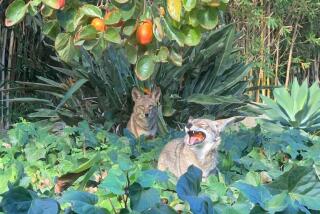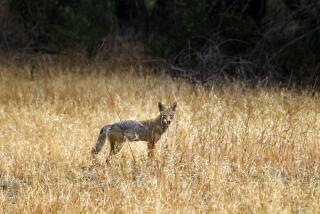Naturalists Dispute Hunters’ Claims : East Debates Just How Wily Coyote Is
- Share via
BELCHERTOWN, Mass. — Human howls fill the night in the woods of New England, where hunters and naturalists are on the prowl for the coyote, which is rapidly replacing man and dog as the chief predator of deer.
In recent years, the rarely seen coyote has grown in such numbers that Massachusetts has started a hunting season and Maine hunters are worried there soon may be more coyotes than deer. Sheep farmers in Maine say the animal is driving some out of business.
But conservationists say that reports of coyote kills are exaggerated and that the animal is doing some good.
“When you look at the vast majority of coyotes in the state, they are providing a degree of balance and diversity in the wildlife community and in the ecosystem,” said Paul Lyons, a wildlife biologist for Massachusetts’ Metropolitan District Commission. “The more diverse the community, the better it is for everybody.”
Lyons is one of the naturalists who howl at night in the huge Quabbin Reservoir in western Massachusetts. The naturalists hope the animal will howl back. From the howls, they say, they can learn where the animals hunt and live.
One thing the naturalists have learned is the coyotes have driven domestic dogs from the reservoir. The dogs had been a predator of the deer.
Massachusetts has an estimated 1,000 coyotes; Maine has at least 16,000, officials said.
The coyote is among the most intelligent of wild animals, say those who track it. Related to the wolf, the eastern coyote is the size of a small German shepherd with a fox-like head, bushy tail and gray-black coat. It averages four feet long from nose to tail tip and weighs about 40 pounds.
The Western coyote migrated east in the 1930s, breeding with the Algonquin wolf along the way and evolving into a larger species.
Since 1980, Massachusetts officials have confirmed 28 coyote attacks on lambs and other small livestock. All but three of the 75 deer carcasses found last winter at the Quabbin reservoir were killed by coyotes, naturalists said.
Massachusetts started coyote hunting in 1981 after a handful of farmers claimed coyotes had killed newborn calves. Since then, hunters have killed 20 to 40 coyotes yearly in Massachusetts, officials said.
The Massachusetts Audubon Society opposed coyote hunting, saying there was insufficient evidence the animals seriously threatened ecological stability. A coyote protection bill failed in the Legislature in 1981, and the farmers prevailed.
Richard Turner, southwestern wildlife district game manager for Massachusetts, said coyotes may even be a help, since they eat animals killed by cars or other causes and keep such pests as rabbits and field mice under control.
Maine hunters and sheep farmers, however, call them a menace. Unofficial estimates of the number of Maine deer killed by coyotes range from 3,000 to 15,000 yearly. Officials have no estimates on sheep killed.
Maine has never banned coyote hunting, and officials said at least 1,600 coyotes are killed by hunters and farmers annually.
One pro-hunting group, the Maine Coyote Control Assn., has offered a $25 reward for each dead coyote during hunting season, which runs most of the winter.
“I’d poison them if I could,” said Connie Skov, a Maine sheep farmer who said she has lost nearly a dozen sheep to coyotes. “They are just no good.”
More to Read
Sign up for Essential California
The most important California stories and recommendations in your inbox every morning.
You may occasionally receive promotional content from the Los Angeles Times.










